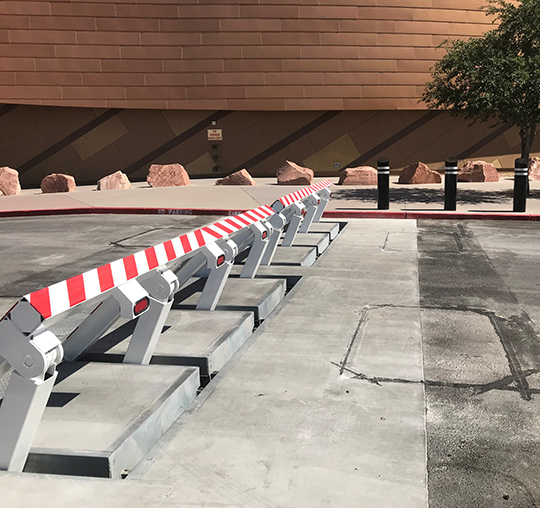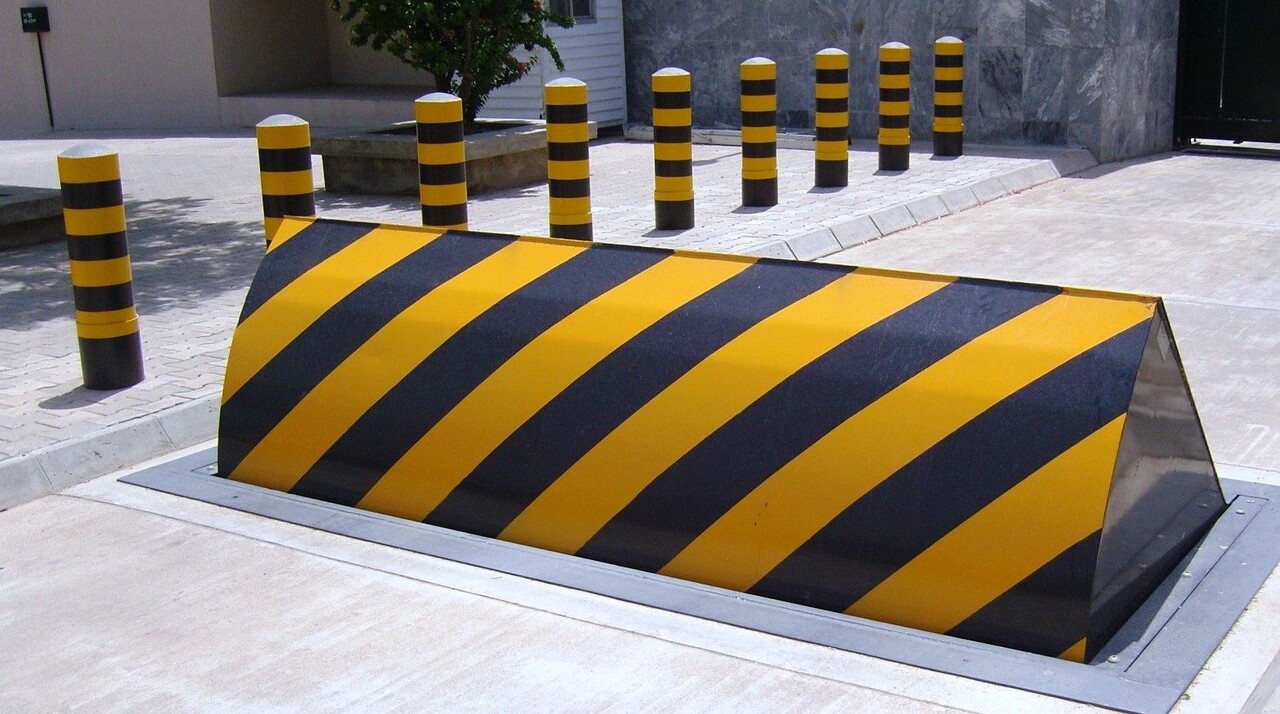Rumored Buzz on Wedge Barriers
Table of ContentsWhat Does Wedge Barriers Do?All About Wedge Barriers


18 may be done quicker, easily, and cost efficiently. FIG. In specific personifications, the support 30 may be a steel structure including plates, light beams(e. g., I-beams ), and/or other structures that are protected within the structure 14, which may be concrete. At the surface 12, an upper side 28 of the anchor 30 might be at the very least partly subjected
, therefore enabling the accessory of the obstacle 10 to the support 30. g., threaded holes)in one or even more beams or plates of the anchor 30 might be exposed to the surface 12. In this fashion, bolts 32 or other mechanical fasteners might be made use of to safeguard the barrier 10 to the support 30. As the obstacle 10 is installed to the surface area 12 of the foundation 14, collection of debris and other product under the obstacle might be minimized, and elements of the bather 10 may not be revealed to below grade atmospheres. As indicated by referral numeral 52, the lifting device 50 consists of parts disposed beneath the wedge plate 16. For instance, the elements 52 beneath the wedge plate 16 may include an electromechanical actuator, a camera, several cam surfaces, and so forth. Furthermore, the training device 50 includes a springtime assembly 54
The springtime rod 58 is paired to a camera(e. g., web cam 80 displayed in FIG. 4) of the training system 50. The springs 60 disposed about the spring rod 58 are kept in compression by springtime supports 62, including a repaired springtime support 64. That is, the set springtime support 64 is repaired family member to the foundation 14 et cetera of the bather 10.
Wedge Barriers for Beginners
g., springtime support 65 )might be fixed to completion of the springtime pole 58 to enable compression of the springtimes 60. As the springs 60 are pressed in between the springtime sustains 62, the spring assembly 54 generates a force acting on the cam combined to the spring pole 58 in a direction 66. For instance, the remaining pressure related to
the camera to deploy the wedge plate 16 might be offered by an electromechanical actuator 84 or various other actuator. The springtime assembly 54 and the actuator 84(e. g., electromechanical actuator)may run with each other to translate the cam and raise the wedge plate 16.
As mentioned above, the springtime assembly 54 puts in a consistent force on the camera, while the electromechanical actuator may be regulated to put in a variable pressure on the web cam, therefore making it possible for the lifting and lowering( i. e., releasing and withdrawing )of the wedge plate 16. In particular embodiments, the consistent pressure applied by the spring setting up 54 may be flexible. g., electromechanical actuator) is handicapped. As will be valued, the springtime setting up 54 might be covered and safeguarded from debris or various other aspects by a cover plate(e. g., cover plate 68 received FIG. 4) that might be significantly flush with the elevated surface area 38 of the structure 14. As discussed over, in the deployed setting, the wedge plate 16 serves to block accessibility or travel beyond the barrier 10. For instance, the obstacle 10(e. g., the wedge plate 16 )might block pedestrians or vehicles from accessing a residential property or pathway. As talked about above, the obstacle 10 is affixed to the anchor 30 secured within the foundation 14,

front braces 71. As a result, the link settings up 72 might pivot and rotate to make it possible for the collapse and extension of the linkage assemblies 72 throughout retraction and implementation of the bather 10. The affiliation assemblies 72 cause activity of the wedge plate 16 to be restricted. For instance, if a car is traveling in the direction of the released wedge plate 16(e. As an example, in one scenario, the safety legs 86 might be expanded duringmaintenance of the barrier 10. When the security legs 86 are released, the safety and security legs 86 sustain the weight of the wedge plate 16 against the surface 12. Consequently, the training device 50 may be shut off, serviced, removed, changed, and so forth. FIG. 5 is partial perspective sight of a personification of the surface-mounted wedge-style barrier 10, highlighting the web cam 80 and the webcam surface areas 82 of the training system 50. Particularly, two web cam surfaces 82, which are referred to as lower cam surface areas 83, helpful resources are placed listed below the webcam 80. The lower webcam surfaces 83 may be dealt with to the surface area 12 (e. As an example, the lower webcam surfaces 83 and the mounting plate 85 might form a solitary piece that is protected to the support 30 by bolts or other mechanical bolts. Furthermore, two camera surface areas 82, which are described as top camera surface areas 87, are placed over the webcam 80 and coupled to (e. In other embodiments, interfering layers or plates might be positioned between the surface 12 and the lower camera surfaces 83 and/or the wedge plate 16 and the top web cam surfaces 87 As discussed above, the webcam
80 equates along the web cam surfaces 82 when the wedge plate 16 is lifted from the withdrawed position to the deployed position. Furthermore, as stated over, the spring setting up 54 (see FIG. 3 )might give a force acting on the cam 80 in the instructions 102 using spring rod 58, which might decrease the force the electromechanical actuator 84 is required to use to the webcam 80 in order to activate and lift the wedge plate 16. 1 )to the deployed position(see FIG. 4). As shown, the web cam 80 consists of track wheels 104(e. g., rollers), which you can try this out get in touch with and translate along the camera surfaces 82 throughout operation.